|
The World's Finest Presents 
THE WORLD'S FINEST MAIN PAGE · SITE SPECIALS · EDITORIALS · FORUM
We'll Always Have Gotham:
The Possible Return of Batman: The Animated Series, Part 8
By Joseph Davis
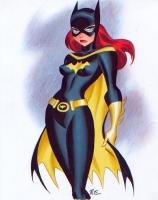
Several essays back, when I was reviewing the potential cast for a Batman: The Animated Series reboot, I glossed over the character of Batgirl, stating that she would be the focus of a future discussion. Well, that time has come. In my now-fanfic reboot of BTAS, I see Barbara Gordon as the other primary cast member, second only to Batman himself. And while some may question the need to clutter the show with a second protagonist, I say this is necessary. Considering Batgirl's tangled thirty-year history in the DCAU, I would argue that she deserves a chance in the spotlight, as well as the opportunity to streamline her characterization because, for each of the three animated Batman shows-the aforementioned BTAS, The New Batman Adventures, and Batman Beyond-each one has presented its own conflicting version of the character.
In her original form, the Barbara Gordon of BTAS was conceived of as a youthful fan of the Dark Knight. Here is a sample of the original write-up for the character, presented in Wizard Magazine #12 (August 1992):
Batgirl / Barbara Gordon is a high-school student who works in the public library. A fan of Batman to the extreme, Barbara's prowlings as Batgirl may land her in trouble. She will guest-star in only a few episodes during the season.
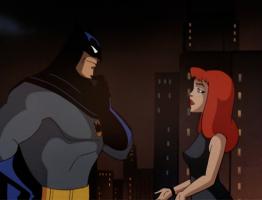 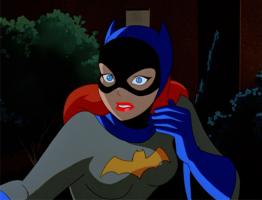 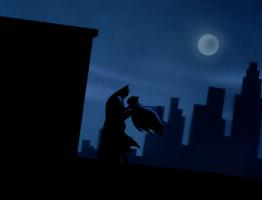
And when she was finally introduced-fortunately aged up to college-level adulthood-in the two-part episode "Heart of Steel," Barbara Gordon (voiced by Melissa Gilbert) was still initially presented as very young (Bruce Wayne's comment about how much she's "grown" implies that he knew her as a child). We even get introduced to her childhood teddy bear, though it was more there due to her father than Barbara herself. However, as the episode progressed, we were allowed to meet the real Barbara Gordon, a woman who is intelligent, perceptive (noticing that her father was replaced by a robot), brave, assertive (using the Bat-Signal to summon Batman, and not being immediately afraid of him), and protective of her own (breaking into Cybertron Industries herself to help Batman and save her father). While not yet Batgirl, we could see the seeds germinate in Barbara's mind-she's had a taste of Batman's world, and she would come to want more.
The next step in Barbara's story would come in the two-part episode "Shadow of the Bat," where Commissioner Gordon is framed by Two-Face and Deputy Commissioner Gil Mason of taking money from Rupert Thorne. When her attempt to get Batman to attend a rally in support of her father didn't happen, she decides to masquerade as the Dark Knight herself. A shootout ensues, and she is outed in the press as "Batgirl," a role that she is more than happy to take on to save her father. Initially treated as an out-of-her-element rookie by the Dynamic Duo, Batman eventually softens his view of her by episode's end (although Robin was not afraid to bust her chops in "Bat" and in the follow-up "Batgirl Returns").
The first, BTAS Batgirl is notable for her rebellious streak. Much like a certain Tomorrow Knight from a few series later, Barbara sees no problem appropriating the bat motif without permission and going out into the Gotham twilight looking for trouble. This no doubt caused headaches for Batman and Robin, as she-while intelligent and capable-was a novice, and novices tend to get killed in this line of work. But the primary focus of this rebellion was no doubt James Gordon himself. Shown early on as a doting father who was proud of his daughter, he still came off as mainly interested in marrying her off (Gil Mason in "Shadow of the Bat," Dick Grayson in Batman: Sub Zero), and Barbara was going to have none of that. But while some young women rebel by getting tattoos and staying out all night drinking, this one decided to rebel against her policeman father by donning the mask of a street vigilante.
It must be said that Barbara Gordon does share one similarity with girls rebelling against dad: a love of bad boys, and the Dark Knight is the biggest bad boy of all. "Batgirl Returns" established that Barbara Gordon has fantasies involving Batman, but who among us hasn't fantasized about someone older than them? I mean, how many teenagers out there do you think entertain thoughts about the 38-year-old Chris Hemsworth? Or 37-year-old Scarlett Johansson? Or 41-year-old Tom Hiddleston? Of course, not every teenager has met their celebrity crush in person like Barbara, but-at this point-her thoughts are nothing more than pipe dreams entertained in between study breaks.
It is around this time that Barbara Gordon begins dating Dick Grayson. What started as an offer for a pizza run ("Batgirl Returns") became serious by the time of Sub Zero (where she was now voiced by the late Mary Kay Bergman) and the flashback in the TNBA episode "Old Wounds," where he seems ready to pop the question. It should be remembered that, at this point, Dick and Barbara were unaware of each other's secret identities, and they were pretty combative with each other while in costume. In a perfect world, one or the other would recognize the seriousness of their budding romance and discuss their other lives quietly and privately. However, before that could happen, Batman-recognizing that Robin is experiencing a rebellious streak of his own, as well as second thoughts regarding dedicating his life to crimefighting-brings her to the Batcave and reveals their identities. However, this causes a divide, as Robin-seeing how Batgirl doesn't have the same reaction to Batman that he does-assumes that she is on his side, and he decides to strike out alone.
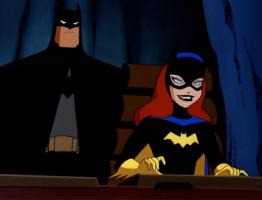 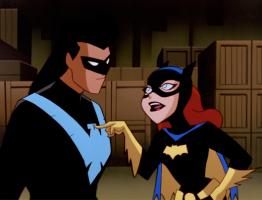
This brings us to the Barbara Gordon of TNBA. Now voiced by Tara Strong, she has now spent roughly two years as apprentice to the world's most dangerous man, and she has excelled in that regard. Her rebellious streak has cooled since being given the keys to the Batcave. In fact, here she acts more like Batman's personal assistant than the brash fangirl who barged into the subterranean boy's club so long ago. She appears to run on pure geek obsession throughout this series-she's just so happy to be there-like she won the coolest internship with the world's greatest boss. The only angst she experiences is in "Over the Edge" where she reckons with the fact that she hides this life from her father. And whereas the returning Nightwing ("Old Wounds") and Robin ("Never Fear") are allowed to question Batman from time to time, Batgirl is in 100% lockstep with the Dark Knight (she has a lot in common with Luthor's Mercy Graves, actually). She's just there, as per the Kids' WB mandate.
 After twenty-four episodes the show was cancelled, but there is a small bit of information available as to what may have happened had The New Batman Adventures continued. In the 2012 book Rough Justice: The DC Comics Sketches of Alex Ross, the artist provided this information about Paul Dini's potential plans for Barbara Gordon, which may have mirrored the injuries she sustained in The Killing Joke: After twenty-four episodes the show was cancelled, but there is a small bit of information available as to what may have happened had The New Batman Adventures continued. In the 2012 book Rough Justice: The DC Comics Sketches of Alex Ross, the artist provided this information about Paul Dini's potential plans for Barbara Gordon, which may have mirrored the injuries she sustained in The Killing Joke:
In 2000, Paul Dini told me of a great idea he had planned for how to deal with the disabled Barbara Gordon / Oracle / Batgirl on the Batman animated series. It involved curing her via the infamous Lazarus Pit that Ra's Al Ghul had used to maintain his immortality for centuries. The process would leave her a darker, more compromised hero, almost vampiric in ferocity, while returning her to her Batgirl lifestyle. We knew there was a plan to bring back the Batgirl persona in the comics, and we pitched Paul's idea with [some Ross] sketches in tow. No luck.
This tracks with another quote from Alex Ross, this one pulled from an October 2007 Newsarama interview (and reprinted in the DC Women Kicking Ass blog):
Paul Dini had this idea of putting Barbara Gordon in the Lazarus Pit to revive her… spine, I guess. At least, that's what he would have done in the television show had they continued doing more cartoons, and her spine was broken the way it was. I thought it was a great idea, and we pitched then-Batman Editor Denny O'Neil with these drawings of that costume design. Denny shot it down because, according to him, everybody loves Barbara Gordon as Oracle and as a handicapped character. The theory was that DC didn't have enough handicapped characters, so they weren't going to do anything with Barbara as she was. And the design went into the drawer.
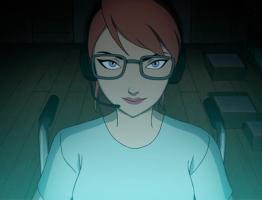 
It should be noted that the Alex Ross Batgirl design would eventually be retooled into the Batwoman character that would debut in 2006. It's also worth noting that the general design (black bodysuit, stylized red bat symbol) strongly resembles the Batman Beyond costume.
Chronologically speaking, Barbara Gordon went unseen during the Justice League / Justice League Unlimited time period. Batman sidekicks traditionally do not join the big team, as they are usually involved with the Teen Titans (Robin, Nightwing) or remain solo (Batgirl herself). And while it may be seen as a preventive measure-you don't want to fill the team with Bat-subordinates to dilute the chain of command-some story arcs, specifically Joe Kelly's JLA story The Obsidian Age (2002-2003)-provide a justifiable reason for this omission. Considering how each member of the League could very easily lead a lesser team-Bruce Timm once joked in Starlog that, "[t]here is no Captain Kirk on [Justice League] because we have a team of seven Captain Kirks!"-Batman would want to ensure that there was at least one Captain Kirk available to lead the team should the "Big Seven" bite the dust. That could easily be Nightwing (as it was in Kelly's story) or Batgirl.
It is worth mentioning that there was almost a Barbara Gordon appearance during this period, but it was dropped due to the dreaded Bat-Embargo, the restriction preventing Batman cast already utilized by the competing Kids' WB The Batman animated series from appearing on Justice League Unlimited. In a proposal that was ultimately dropped, we could have gotten a Birds of Prey episode, as per the late Dwayne McDuffie, from his now-defunct message boards:
I pitched a 'Birds of Prey' episode where, after Batgirl breaks a leg, Batman orders her off the case, and she creates Oracle in retaliation. Huntress and Black Canary do her legwork without ever meeting her in person and crack the case. Batman's suspicious but can't prove it. The story didn't work out, but we did get the terrific Gale Simone's 'Double Date' script instead.
Afterwards, Bruce Timm, on the former Toon Zone message boards, provided some clarification:
Short version: Barbara gets injured, Batman says 'Rest up, get well, no crimefighting, young lady!' She's not just in a wheelchair, she's in traction. Barbara gets restless, defies Batman's orders, and starts working on this week's nefarious plot on her computer (some nonsense about Kirk Langstrom creating an army of Man-Bats).
She realizes she needs 'mobile' help [and] calls Dick Grayson-cut to Dick's apartment, where he's making out like crazy with some gorgeous new gal, the phone rings and rings and rings, [and] he distractedly picks up the phone (still making out), Barbara starts to talk, he doesn't even hear her, [and] just drops the phone back on the cradle. Barbara gives her phone the stink-eye and growls, 'DICK!' At which point Barbara recruits Black Canary and Huntress to be her 'field agents,' and she herself assumes a temporary 'Oracle'-type role.
The army of Man-Bats gets their butts soundly kicked, yada yada yada. And, for the record, Gail Simone had nothing whatsoever to do with that version of the story. All in all, 'Double Date' is a much better story.
The final Barbara Gordon appears on the Batman Beyond series. Voiced here by Stockard Channing (the regular series) and then Angie Harmon (Batman Beyond: Return of the Joker and latter series episodes), she is portrayed as an older Barbara who has become disillusioned with Batman. At some point in the past, a divide occurred between Barbara and Bruce Wayne, and she is now bitterly estranged from her former hero and, much like the rebellious child who swore that they'd never become their parent, she's gotten older and become her parent, not only joining the Gotham City Police, but becoming the Commissioner as Jim Gordon did. It is against this backdrop that a new person has donned the Batman costume, and Barbara is against it.
 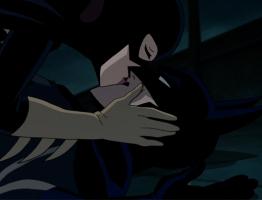
In a revised version of the storyline, the creative team could have easily made Commissioner Barbara Gordon the villain of the series. Convinced that she can do without Batman's help-despite multiple examples of her police department's corruption and incompetence (see the Old Maid's essays on this website for those details)-she takes a hardline stance against vigilantism, putting her at odds with Bruce Wayne and Terry McGinnis, even threatening them with arrest ("A Touch of Curare"). This is an unusual position-previous essays have discussed how the original Batman's presence in Gotham must have provided law enforcement in other jurisdictions with an idea of what costumed crimefighters could provide in terms of security and public relations. This set the stage for the enormous cast of players that would eventually fill the ranks of the Justice League, and the ensuing decades must have proven their worth (Amanda Waller's softened stance in the JLU episode "Epilogue" should be proof of that). So why is Barbara Gordon-who was herself a costumed crimefighter for many years-so against them? The only reason would be personal resentment against Bruce Wayne…and against Terry McGinnis.
Regarding Wayne, this would be the time to discuss the fact that, sometime in the DCAU timeline, Barbara Gordon had a romantic relationship with him, much to the chagrin of the fan base. In a move that, I believe, is a first for the Batman mythos, the creative team decided that having the Dark Knight hook up with his younger partner, who he knew when she was a child, was a good idea (forgive me for not remembering the source, but I recall Timm saying something along the lines of liking the idea that even someone like Batman could make a mistake as his justification). Of course, this pairing would cause a host of problems, as well as tainting their relationships with Jim Gordon, Dick Grayson, and even Alfred. And even though we, the audience, are aware of the fact that at no time was Batman grooming Batgirl for such a role, there's enough of an ick factor to turn off most fans to the concept. Of course, with this in mind, the scenario was revisited in their controversial adaptation of The Killing Joke in 2016.
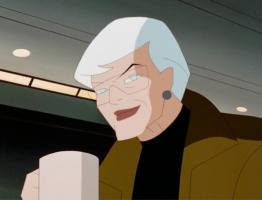 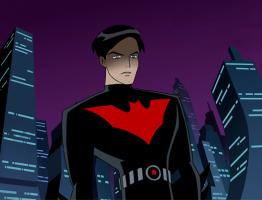
That is not to say, however, that this storyline would necessarily be a bad one. The problem here is that the creative team kept it intentionally vague, allowing fans to conjure any number of worst-case scenarios in their minds. Now, usually Batman is a man of incorruptible integrity, and Barbara-despite her private fantasies-is one as well, but what if this affair occurred at a low point in their lives? Likewise, the age difference between them is another factor. Fans speculate that Bruce is early to mid-30s on BTAS, which would place Barbara in her late teens to early 20s. Not ideal. However, what if the event was pushed up the timeline, to where Bruce was in his mid-40s and Barbara was in her early 30s? That could hypothetically frame their pairing as less of a casual hook-up and more of a reaction to a mid-life crisis and, frankly, age differences in May / December romances become less important the older the participants are. More on this later.
As for Terry McGinnis, I suspect that Barbara Gordon's issue with him has less to do with his rap sheet and more to do with that fact that, like it or not, they have an enormous amount in common. Both were young adults who, during crimes in which their fathers were a casualty, "borrowed" a bat suit to bring the criminal to justice and, after which, an initially disapproving Dark Knight took them under his wing as a favored apprentice. Let's face it: Barbara Gordon, more so than Dick Grayson, must have been considered as the heir to Batman at one point. Despite his otherwise excellent qualities and resume, Grayson is-at heart-a child of the circus who's used to changing addresses. He may like Gotham City, but he doesn't love it the same way Bruce Wayne does. Barbara, on the other hand, is a child of Gotham, like Bruce. As the police commissioner's daughter, she is all-too familiar with the darkness that plagues the city's streets, as well as the light that shines through the actions and deeds of its heroes. You can even see it in their respective superhero names-while Dick was Robin and Nightwing, Barbara went for the gusto as BATGIRL, ostensibly taking on her idol's identity in a way that Grayson never did. And now a new guy comes along and usurps the mantle of Batman, the one that Barbara Gordon coveted decades earlier, as his own? No wonder she had it out for Terry.
The tragedy of Batman Beyond is that, while an interesting idea, its production was so rushed and, presumably, so micromanaged that I doubt the creative team had time to really put that kind of nuance into the development of their characters. Or, as the Old Maid put it, the outcome "gives the impression that Barbara Gordon was only included in the series out of a sense of obligation, but […] no one had specific plans for her."
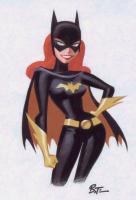 At any rate, the DCAU has provided us three different Batgirls-the rebellious fangirl of BTAS, Batman's gal Friday of TNBA, and the bitter Commissioner of Batman Beyond-and a BTAS reboot would be a wonderful opportunity to fuse these conflicting characters into one, definitive Batgirl. Imagine a series where Batman and Batgirl fight crime in a changing Gotham-sometimes together, sometimes separately. Working alone, Barbara would have the opportunity to develop her own methods and assets-such as, say, Oracle and the Birds of Prey-as well as her own Rogues' Gallery. And, most importantly, she could protect Gotham City solo when Batman is out of town, either due to working another case or serving with the Justice League (in fact, he may allow himself to stay in the League since he has a trusted ally to protect Gotham when he's gone). These storylines would contribute to the narrative arc of this incarnation of BTAS: Batman preparing Barbara Gordon to become his successor. At any rate, the DCAU has provided us three different Batgirls-the rebellious fangirl of BTAS, Batman's gal Friday of TNBA, and the bitter Commissioner of Batman Beyond-and a BTAS reboot would be a wonderful opportunity to fuse these conflicting characters into one, definitive Batgirl. Imagine a series where Batman and Batgirl fight crime in a changing Gotham-sometimes together, sometimes separately. Working alone, Barbara would have the opportunity to develop her own methods and assets-such as, say, Oracle and the Birds of Prey-as well as her own Rogues' Gallery. And, most importantly, she could protect Gotham City solo when Batman is out of town, either due to working another case or serving with the Justice League (in fact, he may allow himself to stay in the League since he has a trusted ally to protect Gotham when he's gone). These storylines would contribute to the narrative arc of this incarnation of BTAS: Batman preparing Barbara Gordon to become his successor.
Batman, while being-well, Batman-would nonetheless be keenly aware of the passage of time regarding his physical prowess, as well as consciously aware that he cannot be Batman forever. He is also a notorious planner and problem solver so, as previously stated, he would choose an inheritor to the mantle if able, and Barbara would be an excellent choice. Of course, we-having seen Batman Beyond-know that this is untenable, but this would be the overarching storyline of my reboot, which would culminate in the final episode, one that I would call "We'll Always Have Gotham."
The story would begin in the future, several weeks after Return of the Joker, with Batman (Terry McGinnis) landing on the roof of the police station and meeting Commissioner Barbara Gordon. He asks why she called him, and she uses the opportunity to apologize, stating that while vigilantism is officially against the law, her pursuit of him was personal (as outlined above). Terry asks why, and Barbara tells him the story of her final days as Batgirl.
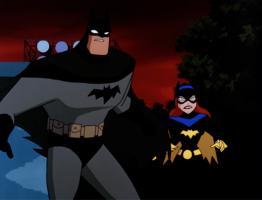
Flashback to, say, five years after the events of my reboot. Barbara is in her early to mid-30s, Bruce Wayne is in his mid- to late 40s, and he's starting to slow down (as per the flashback in "Epilogue"). Dick Grayson is in Jump City with the Titans and married to Starfire. James Gordon and Alfred Pennyworth are dead, and Tim Drake is gone following his breakdown post-Return of the Joker. Most of Batman's original Rogues have either retired, moved on, or have died. Meanwhile, Batman is still in the Justice League, but it has changed as well. Along with the seemingly ageless Superman and Wonder Woman, he manages a League filled with the children and successors of the original members (Jessica Cruz replacing John Stewart as Green Lantern, Miss Martian replacing J'onn J'onzz, Ryan Choi replacing Ray Palmer as the Atom, etc.).
Despite these changes, both Bruce and Barbara continue to fight crime as Batman and Batgirl, respectively, but it has come to dominate their lives (in Bruce's case, more so than before). Barbara has an apartment in Gotham City, but she's moved into Wayne Manor for the sake of convenience and stays in a guest room. She also receives a weekly stipend from Bruce so she can avoid having a day job, allowing her to be Batgirl full-time. Their lives are starting to blur together. Meanwhile, Bruce-feeling his age-begins working on a prototype of the Batman Beyond suit, seeing it as a way to augment his failing strength and speed.
Suddenly, during a mission, Batman collapses. Following a medical examination by League physicians, they discover that, due to age and the general punishment he's taken over the years, he has a heart condition. He cannot be Batman anymore. The Justice League puts him "on leave" and Barbara forces him to take a sabbatical. She can watch over Gotham City, just like he trained her to. But Bruce doesn't take it well.
(Let me take a moment here to say that, prior to the events of this story, in an earlier reboot episode, Batman and Batgirl discover a Lazarus Pit in Gotham, perhaps in the lowest depths of the Batcave itself.)
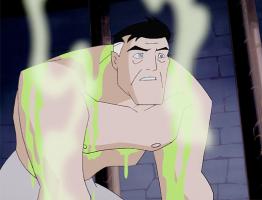
One night, following an evening of crimefighting, Batgirl returns to the Batcave and hears a sound. She follows the noise to find Bruce standing in front of the Lazarus Pit, talking to himself. He's audibly weighing his options-while he may have recognized the dangers of the Pit previously, now it's looking like a viable option. By extending his life, he can continue being Batman in perpetuity. The only thing holding him back is whether he can maintain his morality in a way that Ra's Al Ghul could not. This scene should be reminiscent of the graveyard scene in Mask of the Phantasm, where he begs his parents give him a sign that it's okay to break his promise. Here, however, it's his equivalent of a mid-life crisis-whereas before he was asking permission to not dedicate his life to being Batman, here he's asking when it's okay to stop.
(Yes, I know that this may contradict the Batman Beyond episode "Out of the Past," but consider that people's opinions can change over time. Whereas a 40- to 50-year-old Bruce Wayne may feel this way, an older, geriatric Wayne may have considered his options and temporarily thought, "What the hell, why not?")
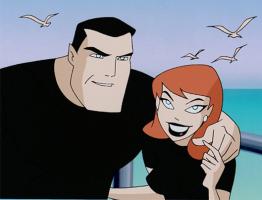
It is at this point that Barbara approaches Bruce and talks him down from the ledge, and-either due to shared trauma, mid-life crisis, or maybe because they're lonely and realize that the other is the only person left in their life-they make a mistake. One kisses the other, and the other kisses back.
Months pass, and Bruce and Barbara invest in their new relationship. Understanding the circumstances, Dick gives them his blessing, as do Clark and Diana. Barbara continues to fight crime, and Bruce accompanies her remotely via the Batcomputer (much like he would with Terry decades later). And, together, they plan her next step as a crimefighter-modifying the prototype bat suit, they will officially launch the beginning of a new era with Barbara's new costumed identity of Batwoman. As was Batman's original plan, Barbara will assume the role of the new primary protector of Gotham City, and Batman will retire from active duty.
 However, tragedy strikes as, during a shootout with Black Mask's gang, Barbara is shot. Bruce, seeing this remotely, contacts the Justice League and orders an emergency beam out. Arriving on the moon, he discovers that she has been shot through the spine, causing paralysis. Enraged, Bruce-knowing that he has to keep his cool for the moment-bides his time until things die down in the hospital area, and then he leaves her room, seeking revenge. However, tragedy strikes as, during a shootout with Black Mask's gang, Barbara is shot. Bruce, seeing this remotely, contacts the Justice League and orders an emergency beam out. Arriving on the moon, he discovers that she has been shot through the spine, causing paralysis. Enraged, Bruce-knowing that he has to keep his cool for the moment-bides his time until things die down in the hospital area, and then he leaves her room, seeking revenge.
Barbara immediately realizes this and shouts after him, saying that he could die if he tries to be Batman again. She tries to call the nurse, but Bruce disabled the call button. She suspects that, in this state, Bruce might kill her attacker…or himself.
(While official canon dictates that Batman does not kill, I say this is kinda shaky. Consider the Thanagarian invasion on Justice League-he's sure that nobody died when he crashed the Watchtower into the hyperspace bypass generator in "Starcrossed?" Also, upon seeing what the Joker did to Tim Drake in Return of the Joker, I'm pretty sure he aimed for the Joker's head when he threw his knife. Finally, for an example from the comics, check out Infinite Crisis, where Batman-upon seeing Alexander Luthor strike down Nightwing, almost killing him-nearly puts a bullet in his head until he is talked down by Wonder Woman. In short, Batman could potentially kill out of anger.)
Thinking fast, Barbara calls Nightwing and Starfire, and she convinces them to sneak her out of intensive care and back to the Batcave. Upon returning, she sees that Bruce has taken the prototype suit and adjusted it to fit him. She directs Dick and Starfire to bring her to the room with the Lazarus Pit and orders them to toss her in.
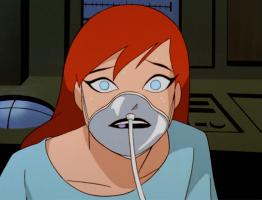 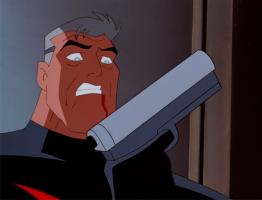
Barbara emerges fully healed from the pit and, after the momentary insanity wears off (where she proves more than a match for both Nightwing and Starfire), they track down Bruce. Momentarily distracted by the sight of a rejuvenated Batgirl, she incapacitates Bruce with knockout gas and takes out Black Mask herself.
Bruce wakes up in the Batcave with Barbara watching over him. Bruce confronts her, recognizing that she used the Lazarus Pit after they mutually agreed that it was a bad idea, and Barbara cuts him off, saying that he promised to stop being Batman. Barbara now realizes that, while Bruce consciously planned to pass the mantle to her, unconsciously he cannot stop being Batman because he cannot be anyone else. Bruce cannot change, and she loves him too much to see him kill himself trying to continue being Batman. She quits as Batgirl, leaves the mansion, and-as she has no resume or job prospects-uses her father's connections to join the police academy. She'll continue to fight crime, but as her father would, not as Bruce would.
Bruce destroys the Lazarus Pit and continues operating as Batman for an undetermined period, until the events of the beginning of "Rebirth," where he has a heart attack and nearly shoots a criminal with a gun to protect himself. Faced with the fact that he must quit, he does-only to [falsely] realize that he's nothing without his costumed identity. Falling into depression, he retreats to the mansion, severs ties with the Justice League, and allows his company to be taken over by Derek Powers (this may explain the scaled-down Justice League of "The Call"-no Wayne Enterprise money). And there he remained…until Terry showed up.
The flashback ends, and Barbara reveals the real reason why she called Terry: after consulting with Bruce and her husband, District Attorney Sam Young, they have decided to deputize Batman, allowing him to work with the GCPD. Recognizing that there were problems in her department (corrupt cops, etc.), she is working to correct these issues and, seeing his bravery and skills in defeating Joker II, bringing Terry "in-house" is a vital step. Terry is overwhelmed, but Barbara isn't done. To seal the deal, she has built a new Bat-Signal, with the updated bat symbol (when lit, the symbol is red in the sky-problematic on TNBA, but it would look good here, as Batman Beyond's night sky is always purple).
 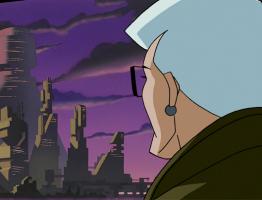
Looking at the new Bat-Signal, Terry asks Barbara if she still loves Bruce. Barbara laughs, saying that she loves her husband, but Bruce is the one that got away. In her way, in fact, she's always loved Bruce Wayne and, hopefully, someday Bruce will love Bruce too. She then pauses, looks out over the city-the one she's spent decades protecting-and then smiles and says, "But we'll always have Gotham." The scene ends with Barbara and Terry looking out over the city skyline.
***
And so ends my multi-essay thought experiment laying out my vision of a BTAS reboot. I can say with confidence that this probably won't happen, but I've had fun researching and building my take on a post-JLU Gotham City and Batman's adventures therein. I'd like to thank James Harvey for posting these essays on The World's Finest-I've missed this almost as much as I've missed the DCAU itself.
Finally, considering how Batman: Caped Crusader is scheduled to air mid-2023, I suspect that we'll begin hearing news about it in the coming months (frankly, I'm surprised that we didn't hear anything at this year's San Diego Comic-Con). Nevertheless, I'm eager to see if Timm's new vision of the Dark Knight is better than my own.

Click here to discuss this editorial!
Previous installments of "The Possible Return of Batman: The Animated Series":
-Part 1: Why So Reboot?
-Part 2: Rebooting Gotham
-Part 3: The Usual Suspects
-Part 4: Bring on the Bad Guys
-Part 5: The Rogue's Gallery
-Part 6: The New Blood
-Part 7: Everybody Loves a Clown
Joseph Davis is a long-time contributor to the community, having run the Justice League Watchtower website and posting on WF forums under the name "Karkull" over the past 20 years.
Follow The World's Finest on
Twitter - Facebook
 |